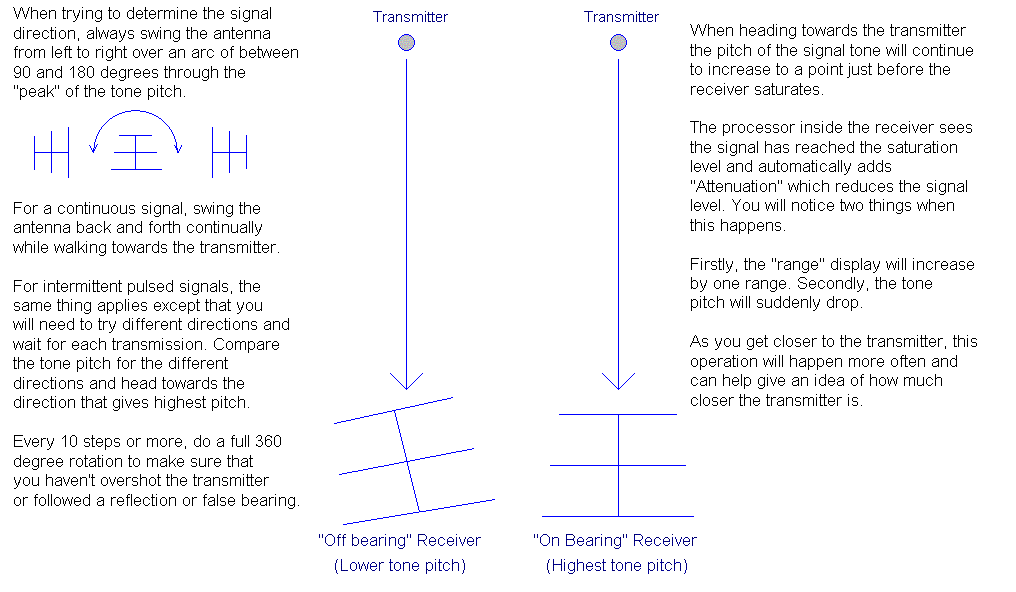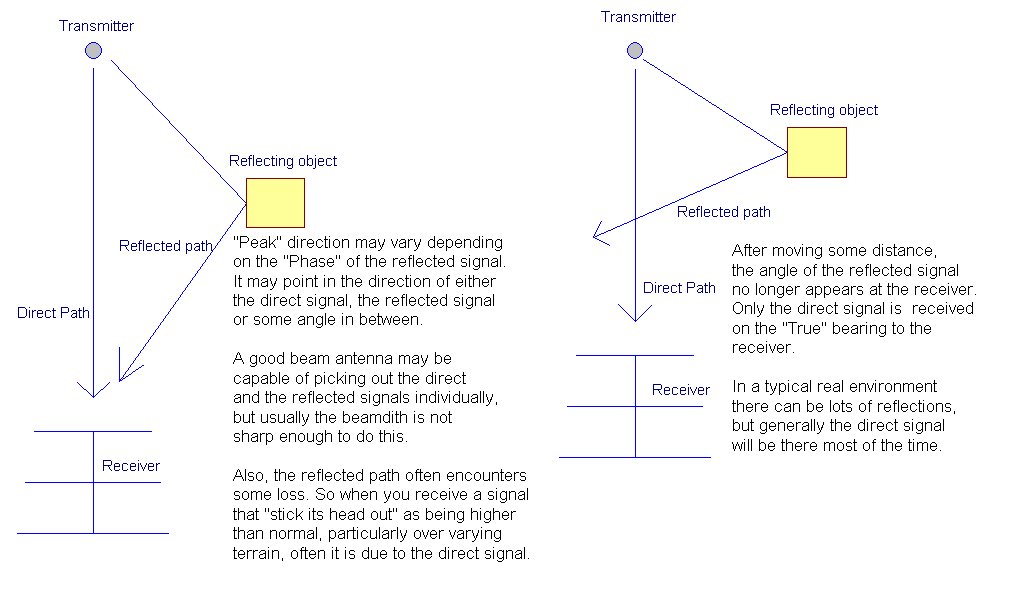Using the MK4 foxhunt receiver to hunt
short duration pulsed transmissions.
The VK3YNG MK4 foxhunt sniffer (V2.2
or later) has a special mode for hunting very short duration "pulsed"
or “pip”-like
sounding transmitters.
These beacons have transmission times of typically around 40
milliseconds and are often used for tracking animals, rockets and
model aircraft.
These short transmissions can be very hard to deal with when
listened to in the standard tone modes on the VK3YNG sniffer. The
transmission
is usually so short that the user cannot distinguish the audio tone
pitch to
determine a direction. The MK4 sniffer has a new “peak extend” mode
which
stretches
out the received pulse so that its signal level and resultant tone can
easily
be determined.
Setting up Peak Extend mode
To successfully look for these very
short
duration transmissions, the sniffer needs to be set up in “peak
extend” mode
with a range down delay of 5 seconds. To set this mode:
- Make sure the sniffer is turned off
- Press and hold the “6” button on the
sniffer
- While holding this button, power up
the sniffer with the “M” button
- The sniffer will beep and briefly
display “J”
- Press the “7” or “dset” key. The
sniffer will display “d”.
- Press the “5” key
- The sniffer is now configured for
“peak extend” mode
The peak extend mode only needs to be
set once. The sniffer
will remain in this mode for each subsequent use until another filter
mode is
set
For pulsed transmissions that only
occur every few seconds
or longer apart, it may also be useful to activate “Peak hold” mode.
For more
information on this mode, consult the sniffer
operation manual.
Note that if the
sniffer is to be
used for finding longer
pulsed intermittent or continuous transmissions, the peak extend mode
may be
confusing. For hunting these signals, filter modes 1 through 3 are
recommended.
Filter mode “1” is the factory default. Also a range down delay of 5
seconds
may be too long. A setting of around 2 seconds may be more appropriate.
For
more information please refer to the sniffer
operation manual.
Using the Sniffer
Using the sniffer to locate a signal
source is
straightforward and intuitive. Just remember the motto “highest range
then highest tone”. Once the
sniffer is powered up and the frequency or
channel selected, operation is effectively hands free.
Power control and receive mode.
The sniffer is capable of receiving
in 4 standard modes.
These modes are Tone, AM,
Unmuted FM and Muted FM. Pressing the
“M” button powers up the receiver and cycles through these receiving
modes. In
most cases the “Tone” mode will be used to determine signal
directions.
The sniffer indicates this mode by briefly showing “t” on the display
after the
“M” button is pressed. Pressing and holding the “M” button for more
than a few
seconds will power down the receiver.
Channel selection
The receiver always powers up on the
mode and frequency
stored in channel 1. There are a total of 6 programmable channels on
the
sniffer. Recalling any channel is just a matter of pressing the
appropriate
channel button. For information on setting channel frequencies please
refer to
the sniffer
operation manual.
The range display
The range display is effectively a
measure of how much
signal the sniffer is receiving. In effect it tells you how close you
are to
the signal source.
- 0 = Extremely weak or no signal
- 5 = Close to a medium power transmitter
- 9 = Very close to a very strong
transmitter
The maximum number displayed when you
point directly at a
very close signal source will vary depending on how strong the
transmitter is.
A bit of practice with a typical transmitter will help you determine
how the
range display indication varies with distance.
Note: When you
first set the
frequency in peak extend
mode, it may take a few pulses before the tone is properly heard,
especially if
the pulse duration is very short. It can take a few transmissions for
the
sniffer to determine the proper range to use. Once it has done so, the
tone
will be heard clearly.
Direction Finding Techniques
Using the sniffer for direction
finding takes a little
practice, but it doesn’t take long at all to become proficient enough
at it to
find any transmitter.

A few tips to remember
- Always hold the receiver so the
display can be easily seen and the speaker easily heard.
- Always keep sweeping the receiving
antenna from left to right over a 90 to 180 degree arc while
approaching a transmitter or signal source.
- Every few minutes, do a slow and
complete 360 degree spin to ensure that you have not “overshot” the
signal source or been fooled by a strong or local reflection.
- Always remember the motto “Highest
range then highest tone” while using the sniffer.
The Multipath problem
A major problem to contend with at
VHF and higher
frequencies is a phenomenon called “multipath”. This is where signals
reflect
off other objects such as metallic structures, hills and even
vegetation.
Signals in this case appear either skew or appear to come from multiple
directions (hence the
term
“multipath”). A good antenna can help sort out some reflections
from the
wanted signal, but in many cases reflections become something that you
just
have to deal with.

The useful thing to know about
reflections is that they come
and go. In most cases if you always make the effort to determine the strongest
signal, you will eventually end up at the signal source. With a bit of
practice
you can get fairly good at working out which signal is a reflection is
which is
a direct signal. The major thing to remember is to keep moving. Even if
you do
start following a reflection, you probably won’t be doing so for long.
Multipath is a bit more difficult to
deal with for
intermittent signals but the techniques are the same.
Final Comments
With a bit of practice, hunting any
signal source should be
simple and straightforward with the MK4 sniffer. The peak extend mode
makes
hunting for short pulse signals almost as easy as continuous ones.
Once the receiver is properly set up,
there should be no
need to do any adjustments from the time the signal is first received
through
to when the transmitter is found. Using the MK4 sniffer to quickly and
successfully find any signal source should be easy for anybody
regardless of
age or technical background

